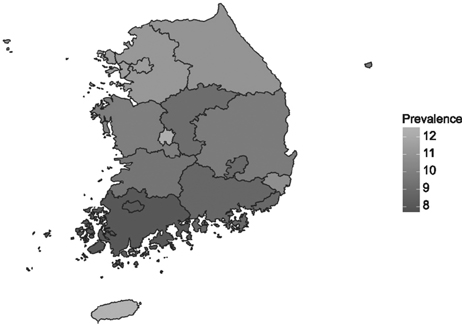World J Mens Health.
2016 Aug;34(2):129-136. 10.5534/wjmh.2016.34.2.129.
Obesity in Korean Men: Results from the Fourth through Sixth Korean National Health and Nutrition Examination Surveys (2007~2014)
- Affiliations
-
- 1Department of Urology, National Police Hospital, Seoul, Korea. sinbanpolee@gmail.com
- 2Department of Urology, Kyung Hee University School of Medicine, Seoul, Korea.
- KMID: 2349849
- DOI: http://doi.org/10.5534/wjmh.2016.34.2.129
Abstract
- PURPOSE
Obesity is related to many diseases, including urological conditions. We investigated the prevalence, risk factors, and treatment of male obesity.
MATERIALS AND METHODS
This study included 17,485 men older than 20 years of age who participated in the fourth, fifth, and sixth administrations of the Korean National Health and Nutrition Examination Survey. Two main cutoff points for obesity were defined: a body mass index (BMI) ≥25 kg/m2 and a BMI≥30 kg/m2. Additionally, we defined obesity requiring pharmacotherapy as the presence of a BMI≥30 kg/m2 or a BMI≥27 kg/m2 co-occurring with at least one associated comorbid medical condition, such as hypertension, dyslipidemia, or diabetes.
RESULTS
The prevalence rates of a BMI≥25 kg/m2, a BMI≥30 kg/m2, and obesity requiring pharmacotherapy were 35.7%, 3.4%, and 10.5%, respectively. The prevalence of obesity increased over time for all definitions of obesity. The prevalence of obesity requiring pharmacotherapy was highest in Jeju (12.5%) and lowest in Gangwon-do (7.7%). Having a higher income, being a non-manual worker, and having completed a high level of education were significantly related to obesity requiring pharmacotherapy. More than 70% of patients with obesity requiring pharmacotherapy reported taking diet pills, eating functional foods, or consuming a one-food diet for weight reduction, but only 13.9% reported exercising for this purpose.
CONCLUSIONS
Male obesity is a common condition, the prevalence of which is expected to continue to increase over time. A better strategy is required to manage male obesity in Korea.
Keyword
MeSH Terms
Figure
Cited by 3 articles
-
Differential Signature of Obesity in the Relationship with Acute Kidney Injury and Mortality after Coronary Artery Bypass Grafting
Hongran Moon, Yeonhee Lee, Sejoong Kim, Dong Ki Kim, Ho Jun Chin, Kwon Wook Joo, Yon Su Kim, Ki Young Na, Seung Seok Han
J Korean Med Sci. 2018;33(48):. doi: 10.3346/jkms.2018.33.e312.The Role of the Urologist in Men's Health
Hyun Jun Park
World J Mens Health. 2017;35(2):57-58. doi: 10.5534/wjmh.2017.35.2.57.Trends in Gallbladder Cancer Incidence and Survival in Korea
Youngjun Wi, Hyeongtaek Woo, Young-Joo Won, Jin-Young Jang, Aesun Shin
Cancer Res Treat. 2018;50(4):1444-1451. doi: 10.4143/crt.2017.279.
Reference
-
1. Kopelman PG. Obesity as a medical problem. Nature. 2000; 404:635–643.
Article2. Rhee SY, Park SW, Kim DJ, Woo J. Gender disparity in the secular trends for obesity prevalence in Korea: analyses based on the KNHANES 1998-2009. Korean J Intern Med. 2013; 28:29–34.
Article3. Park HJ, Moon KH, Lee SW, Lee WK, Kam SC, Lee JH, et al. Mirodenafil for the treatment of erectile dysfunction: a systematic review of the literature. World J Mens Health. 2014; 32:18–27.
Article4. Park YW, Kim SB, Kwon H, Kang HC, Cho K, Lee KI, et al. The relationship between lower urinary tract symptoms/benign prostatic hyperplasia and the number of components of metabolic syndrome. Urology. 2013; 82:674–679.
Article5. Oh SW, Shin SA, Yun YH, Yoo T, Huh BY. Cut-off point of BMI and obesity-related comorbidities and mortality in middle-aged Koreans. Obes Res. 2004; 12:2031–2040.
Article6. Apovian CM, Aronne LJ, Bessesen DH, McDonnell ME, Murad MH, Pagotto U, et al. Pharmacological management of obesity: an Endocrine Society clinical practice guideline. J Clin Endocrinol Metab. 2015; 100:342–362.
Article7. Flegal KM, Carroll MD, Kit BK, Ogden CL. Prevalence of obesity and trends in the distribution of body mass index among US adults, 1999-2010. JAMA. 2012; 307:491–497.
Article8. Zaninotto P, Head J, Stamatakis E, Wardle H, Mindell J. Trends in obesity among adults in England from 1993 to 2004 by age and social class and projections of prevalence to 2012. J Epidemiol Community Health. 2009; 63:140–146.
Article9. Xu W, Zhang H, Paillard-Borg S, Zhu H, Qi X, Rizzuto D. Prevalence of overweight and obesity among Chinese adults: role of adiposity indicators and age. Obes Facts. 2016; 9:17–28.
Article10. Kim CS, Ko SH, Kwon HS, Kim NH, Kim JH, Lim S, et al. Prevalence, awareness, and management of obesity in Korea: data from the Korea National Health and Nutrition Examination Survey (1998-2011). Diabetes Metab J. 2014; 38:35–43.
Article11. Wang K, Wang D, Pan L, Yu Y, Dong F, Li L, et al. Prevalence of obesity and related factors among Bouyei and Han peoples in Guizhou province, southwest China. PLoS One. 2015; 10:e0129230.
Article12. Clinical guidelines on the identification, evaluation, and treatment of overweight and obesity in adults: the evidence report. National Institutes of Health. Obes Res. 1998; 6 Suppl 2:51S–209S.13. Lawson RA, Murphy RH, Williamson CR. The relationship between income, economic freedom, and BMI. Public Health. 2016; 134:18–25.
Article14. Lao XQ, Ma W, Chung RY, Zhang Y, Xu Y, Xu X, et al. The diminishing socioeconomic disparity in obesity in a Chinese population with rapid economic development: analysis of serial cross-sectional health survey data 2002-2010. BMC Public Health. 2015; 15:1282.
Article
- Full Text Links
- Actions
-
Cited
- CITED
-
- Close
- Share
- Similar articles
-
- Trends in General and Abdominal Obesity among Korean Adults: Findings from 1998, 2001, 2005, and 2007 Korea National Health and Nutrition Examination Surveys
- The Prevalence of Obesity, Abdominal Obesity and Metabolic Syndrome among Elderly in General Population
- Letter: The Risk Factors of Sarcopenia among Korean Elderly Men: Based on 2009 Korean National Health and Nutrition Examination Survey Data (Korean J Obes 2014;23:23-31)
- Comparison of Obesity and Overweight Prevalence Among Korean Adults According to Community Health Survey and Korea National Health and Nutrition Examination Survey
- Trends in the Prevalence of Obesity and Its Phenotypes Based on the Korea National Health and Nutrition Examination Survey from 2007 to 2017 in Korea






